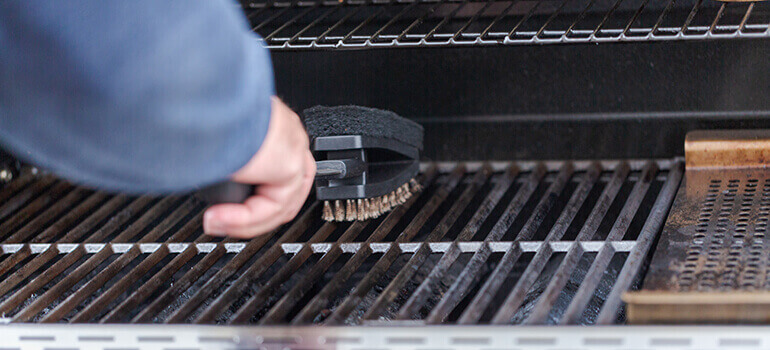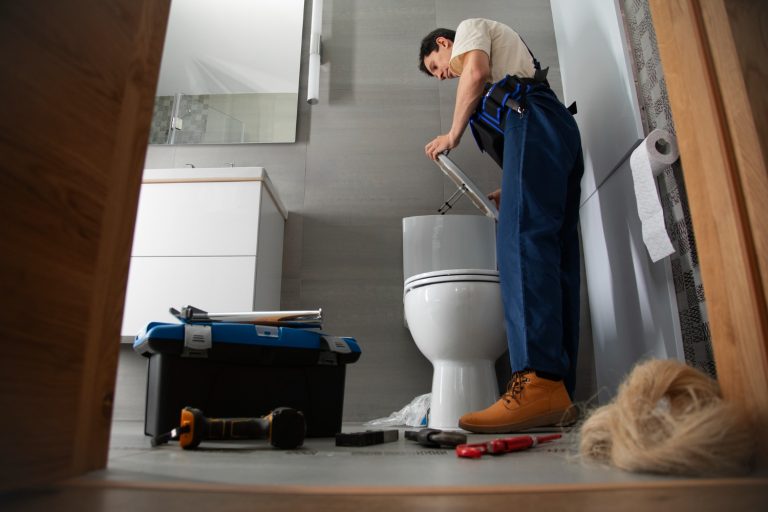
Table of Contents
A kitchen disaster may be discouraging. We can’t cook in a filthy kitchen, and having to clean it before I can begin saps my energy. As a result, the kitchen must maintain a minimal level of cleanliness and order. To set the stage for a seamless cooking experience, start with an empty dishwasher and a tidy workspace. This proactive approach not only keeps distractions at bay but also maximizes efficiency. With the dishwasher ready to take on rinsed dishes, and ample counter space for prepping your ingredients, you’ll find the cooking process more enjoyable and less stressful.
Maintaining a clean kitchen isn’t just about aesthetics; it’s about function and flow. By ensuring your kitchen is organized from the start, you pave the way for creativity and focus, turning cooking from a chore into a delightful experience.
Make Dishwashing Less Difficult
If it takes too much work to deal with dirty dishes and cutlery, pots, and pans, they will build up in the sink. However, you can prevent this by incorporating a simple strategy into your routine.
While waiting for something to simmer or boil, take that time to wash a few dishes or wipe down the countertops. This multitasking approach keeps your kitchen tidy throughout the cooking process. Wash as you go, clean as you wait is a powerful habit that ensures your kitchen doesn’t become overwhelmed with mess.
After supper, run your dishwasher and empty it before night so you can start the day with a clean sink. Is there no dishwasher? While you’re resting after dinner, let hand-washed dishes dry on a rack. By staying proactive and using downtime wisely, you’ll find that managing the kitchen becomes significantly easier.
Maximize Waiting Times for a Cleaner Kitchen
Do you find yourself with idle time while cooking, like when you’re waiting for something to simmer? Use this opportunity to wash dishes and tidy up countertops. This proactive approach prevents the accumulation of dirty dishes and keeps your kitchen looking spotless. By integrating cleaning into these natural breaks, you’re maintaining a more organized cooking environment.
When You’re Cooking, Use Scrap Bowls
When you collect kitchen leftovers in a bowl while you cook, you’re less likely to dump them on the floor. After you’ve completed your dinner, collect the scraps and add them to your compost pile, if you have one. Alternatively, place them in the freezer for later use.
By adopting these strategies, you can seamlessly incorporate cleanliness into your cooking routine, making kitchen maintenance feel less like a chore and more like an integral part of the process.
Why Soak Pots and Pans with Stuck-On Food in Soapy Water?
Stuck-on food residue can turn post-cooking cleanup into a daunting task. But there’s a simple solution—soaking your pots and pans in soapy water. Here’s why this method is effective:
- Ease of Cleaning: By filling your cookware with hot, soapy water and allowing it to sit, you significantly reduce the effort needed to clean. The warm water works to loosen stubborn food particles, making them easier to scrub away.
- Preservation of Cookware: Scrubbing with excessive force can damage the surface of your pots and pans, especially those with non-stick coatings. Soaking minimizes the need for harsh scrubbing, helping to maintain the integrity and extend the life of your kitchenware.
- Time Efficiency: While it might seem that soaking takes longer, it actually saves you time in the long run. You won’t need to spend additional time and energy scrubbing away at food remnants that have been loosened by soaking.
- Improved Hygiene: Soapy water not only loosens debris but also starts the sanitization process. This step ensures that your cookware is not only visibly clean but also free from harmful bacteria.
Simply fill each dirty pot or pan with hot water and a few drops of dish soap, and let them sit while you tackle other tasks. You’ll find that clean-up becomes a breeze!
The Benefits of Having Plenty of Dishtowels Available While Cooking
Cooking can be a messy affair—splashes, spills, and unexpected messes are par for the course. This is why it’s incredibly beneficial to have plenty of dishtowels on hand in the kitchen.
1. Quick Cleanups
During meal prep, there are bound to be spills and splatters. Having a stash of dishtowels ready allows you to tackle these messes immediately. Instead of scrambling for paper towels or other quick fixes, a dishtowel can efficiently mop up liquids or clean surfaces without delay.
2. Eco-Friendly Choice
Ditching disposable paper towels in favor of reusable dishtowels is not just practical; it’s environmentally friendly. By reducing waste, you’re making a small, yet important contribution to sustainability every time you cook.
3. Versatility in Use
Dishtowels aren’t just for cleaning messes. They can also serve as makeshift potholders for handling hot pots and pans, or even as a drying station for freshly washed produce.
4. Cost-Effective
Investing in a collection of quality dishtowels can save money in the long run. Unlike paper towels, which need constant replenishing, dishtowels can be washed and reused countless times. In the end, this cuts down on ongoing costs and reduces household waste.
By ensuring a ready supply of dishtowels, you’re not only making your cooking experience smoother but also friendlier to your wallet and the planet.
Keep Counters Clean During Food Preparation
Use a cutting board while chopping veggies. Raw meats should be prepared on top of a rimmed baking sheet that can be thrown in the dishwasher. On top of the parchment paper or silicone surface you’re baking on, roll out pastry or dough. The less items that come into touch with your counters, the cleaner they will remain.
Why You Should Stock Up on Chopping Boards for Cooking
Having multiple chopping boards on hand can significantly streamline your cooking process. Here’s why:
Efficiency in Cooking
When recipes involve numerous steps and ingredients, the right tools can make all the difference. With several chopping boards at the ready, you can easily transition from slicing vegetables to preparing meat, without the disruption of cleaning up in between. This saves precious time, allowing for a smoother, more efficient cooking experience.
Maintaining Hygiene Standards
Using different boards for various food types prevents cross-contamination. One board for raw meat, another for vegetables, and a separate one for bread can drastically reduce the risk of spreading bacteria. This practice is vital for maintaining food safety and ensuring that your meals are as healthy as they are delicious.
Ease of Cleanup
Messy boards can pile up quickly during meal prep. Having backups means you can swap out a soiled board for a clean one swiftly. This keeps your kitchen environment tidy and lets you focus on the task at hand rather than the cleanup chore looming over you. Once you’re finished, it’s easy to give the used boards a wash, and if necessary, pop them into the dishwasher.
In Summary
Stocking up on chopping boards enhances both the efficiency and safety of your cooking process. By having them ready, you ensure a seamless workflow and uphold hygiene standards, turning potential cooking chaos into a culinary breeze.
You may also like to read: “How effective is vinegar as a cleaning product really?“
How Cleaning as You Go Boosts Cooking Efficiency
Streamlines Workspace: Keeping your workspace tidy by cleaning as you go ensures a more organized environment. When utensils and ingredients are easy to locate, you spend less time searching and more time focusing on what matters most: cooking.
Saves Time: By eliminating clutter, you streamline your cooking process. Wiping down surfaces and rinsing dishes as you finish using them reduces the workload at the end, freeing up precious time for other tasks.
Enhances Focus: A clear workspace minimizes distractions. With fewer interruptions, you can concentrate on perfecting recipes, leading to quicker, more efficient meal preparation.
Reduces Stress: Knowing everything is in its rightful place can significantly cut down on the chaos of cooking. This not only makes the process more enjoyable but also helps achieve better results.
Facilitates Smooth Operations: By keeping everything in order, transitions between different cooking stages become seamless. You can shift from prepping to cooking to plating without unnecessary delays or disruptions.
Adopting a clean-as-you-go habit not only fosters a more efficient cooking routine but also enhances the overall culinary experience.
Pour, measure, and spray your sink

No matter how cautious you are, certain kitchen activities leave a mess on kitchen floors. Using cooking spray, measuring ingredients, or ladling soup into serving dishes are just a few examples. If you don’t like cleaning your kitchen countertops after each meal, do it over dishes in the sink. Then it’s only a matter of rinsing the mess away and leftover food.
When you’re cooking, use scrap bowls
When you collect kitchen leftovers in a bowl while you cook, you’re less likely to dump them on the floor. After you’ve completed your dinner, collect the scraps and add them to your compost pile, if you have one. Alternatively, place them in the freezer for later use.
You may also like to read: “How effective is using baking soda to remove stains?“
Preventing Splatters on the Stovetop
Have you ever avoided certain dishes because you’re afraid they’ll spatter grease all over your kitchen? You don’t have to eliminate those dishes from the menu. Use a wire splatter guard if you can’t cover the pan while cooking . After each usage, throw it in the dishwasher or give it a quick deep clean.
When microwaving, use a good cover
It’s wasteful to cover microwave items with a paper towel, and they don’t always stay place. For a cover that remains in place, use a plate or an overturned bowl. Alternatively, you may use these low-cost microwave splatter shields as we do.
Place coasters on top of the condiments and jars

Use washable coasters to avoid condiments from spilling all over your shelves. They’re ideal for items like honey or syrup that adhere to cupboard shelves. All you have to do to clean the pantry is wash the coasters and wipe not scrub the shelves.
Line the inside and outside of your refrigerator with liners
Refrigerator shelves and drawers may be made easier to kitchen clean by lining them. On shelves, use cling wrap or transparent liners. Keeping food fresh for longer by using newspaper or paper towels in drawers is also a good idea. But don’t stop with the shelves! Use a tea towel to cover the top of your fridge to gather dust, and wash it every couple of weeks.
Use Baking Mats, Parchment Paper, and Foil for Effortless Cleanup
To simplify your kitchen cleanup even further, line your baking sheets and pans with parchment paper, foil, or silicone baking mats. These materials act as a barrier between your food and the cookware, capturing spills and debris.
- Parchment Paper: Ideal for baking cookies and pastries, it prevents sticking and makes transferring baked goods seamless.
- Foil: Perfect for roasting meats and vegetables, it contains juices and flavors while keeping pans spotless.
- Silicone Mats: These reusable liners are excellent for non-stick baking and roasting, offering an eco-friendly alternative.
Once you’ve finished cooking, simply remove the liner, and with it, most of the mess. This not only saves time scrubbing pans but also keeps your kitchen tidier overall.
Make Cleanup a Breeze with Baking Mats, Parchment Paper, and Foil
Just as liners simplify refrigerator maintenance, baking mats, parchment paper, and foil can transform your cooking experience. Line baking sheets and pans with these materials to drastically reduce cleanup time. After cooking, you can effortlessly remove the liner along with most of the mess, leaving you more time to enjoy your meal and less time scrubbing pans.
Whether it’s keeping your refrigerator spotless or your baking trays easy to clean, these simple liners can make kitchen maintenance a breeze. Embrace these small changes for a big impact on your daily routines.
You may also like to read: “What is the purpose of cleaning?“
Use Your Oven to Catch Drips

Using foil on the bottom of your oven can cause a fire and will almost certainly violate your warranty. But it doesn’t mean you have to accept baked-on messes. Place a baking sheet on a rack underneath dripping items such as casseroles, frozen pizzas, or lasagnas. After cooking, remove the sheet, allow it to cool, and then place it in the dishwasher makes your oven cleaning simple.
Ensure that the trash can is easily accessible
The garbage can should never be placed under the kitchen sink. If it’s not easily accessible, you’ll end up leaving things on the counter, where they’ll be forgotten. You won’t have to empty the garbage can as often if you switch to a self-contained, foot-operated trash can. Do you have a problem with garbage can odors? To collect drips, tuck newspaper coated with baking soda in the bottom. When you take out the garbage for disposal replace it.
You may also like to read: “How to clean your oven in 5 minutes ?“
How a Clean Kitchen Enhances Multitasking While Cooking
A tidy kitchen isn’t just pleasing to the eye; it’s a powerhouse for multitasking. Here’s how:
- Streamlined Workflow: With everything in its place, you can seamlessly move from chopping vegetables to stirring sauces without any hitches. A clutter-free countertop means you won’t waste time searching for that elusive spatula or spice jar.
- Efficient Use of Time: Simultaneously manage multiple cooking tasks by making the most of your waiting time. While a pot simmers, take a moment to rinse off cutting boards or organize utensils. This keeps your workspace orderly and reduces clean-up time later.
- Minimized Stress: A clean environment reduces mental clutter. Fewer distractions mean you can focus more on the timing and techniques necessary for different dishes, improving the overall cooking process.
- Enhanced Safety: A neat kitchen is a safer kitchen. By keeping pathways clear and ensuring spills are promptly wiped up, you’re less likely to have accidents, allowing you to multitask with greater confidence.
Keeping your kitchen clean and organized can transform the cooking experience from chaotic to efficient, all while allowing you to juggle multiple tasks like a pro.
Make cleaning the floor at night a breeze

When you use a dustpan, brooms send dust flying throughout the room and create a line of debris. In the kitchen, instead, use a cordless vacuum or a powered sweeper. Every night, run it beneath your table and at the base of your cabinets to keep your kitchen clean looking spotless and smelling fresh.
Tidy for 5 Minutes Every Day
Tuck a cloth and non-toxic cleaning spray beneath your sink to make cleaning routine. Spray and wipe the fronts of your appliances, any open space on your countertops, and the tabletop once a day. To finish, rinse the towel and add some soap before giving your sink a fast wipe.
Easier Cleanup at the End: By integrating this quick daily routine, you ensure that your kitchen remains consistently clean. This approach prevents a buildup of clutter and grime, making the end-of-day or end-of-cooking cleanup less overwhelming. Just like tidying as you cook, maintaining your kitchen in small increments saves you from confronting a daunting mess later. Keeping things manageable allows you to enjoy your kitchen more and stress less about the cleanup.
Embrace the “Clean as You Go” Mentality
Incorporating a “clean as you go” mentality in your kitchen routine can transform your cooking experience. This approach isn’t just about tidiness; it brings a host of benefits that can enhance your culinary adventures.
- Efficiency: By keeping your workspace clean, you can easily find utensils and ingredients, saving time and making the cooking process smoother.
- Safety: A tidy kitchen minimizes hazards. Promptly cleaning spills prevents accidents like slips, while reducing clutter helps avoid knocking over sharp knives or hot pans.
- Stress Reduction: Cooking multiple dishes can be overwhelming. A clean and organized kitchen reduces chaos, making the process more enjoyable.
- Multi-tasking: With a clutter-free environment, you can easily multitask. Use downtime while cooking to clean and put away items, keeping your space organized.
- Maintaining Focus: A neat workspace allows you to concentrate better on recipes, reducing the chance of forgetting ingredients or steps.
- Easier Cleanup at the End: By tackling small messes throughout the cooking process, you’re left with a manageable cleanup, avoiding a daunting pile of dishes at the end.
- Positive Habit Formation: Regularly practicing “clean as you go” turns tidiness into a habit, promoting an efficient and well-organized kitchen over time.
Adopting these practices alongside your daily five-minute tidy can significantly improve your kitchen’s functionality and your overall cooking experience.
You may also like to read: “The Most Creative Ideas in the Cleaning Industry“
The Importance of Designating a Spot for Cooking Tools
When you’re in the midst of cooking, the last thing you want is to waste time hunting for your measuring spoons, cups, or utensils. By designating a specific area for these essential tools, you streamline your cooking process and make your kitchen more efficient.
- Efficiency and Time-Saving:
- Having a designated spot means everything is within arm’s reach. This minimizes interruptions during cooking and allows you to maintain your workflow without unnecessary distractions.
- Reduces Clutter and Clean-Up:
- By consistently placing measuring cups, spoons, and knives in a specific area, you reduce the number of items you need to clean post-cooking. This also prevents your countertop from becoming a cluttered mess, making the space feel more organized and inviting.
- Enhances Safety:
- Knives and sharp utensils stored in one spot decrease the chances of accidental cuts or injuries. It ensures these tools are returned to their safe location after use, out of the way of accidental knocks.
- Improves Accessibility:
- Keeping these items readily accessible not only speeds up your cooking but also encourages you to use the right tools for the job, leading to better quality in recipes. There’s a certain satisfaction in knowing exactly where each tool is when you need it.
- Consistency in Cooking:
- By having your tools readily available, you can measure ingredients more accurately, maintaining consistency in your dishes. This is especially important in baking, where precise measurements are crucial.
In summary, organizing your cooking space by assigning specific spots for your key tools is not just about tidiness; it’s a strategy for creating a seamless and enjoyable cooking experience.
Benefits of Embracing a “Clean As You Go” Approach in the Kitchen
Adopting a “clean as you go” mindset while cooking can transform your kitchen experience. Here’s how this approach can make a tangible difference:
Boosts Efficiency
By organizing your workspace as you cook, you minimize the time spent searching for tools or ingredients. This streamlined process enhances your efficiency, enabling a smoother culinary journey.
Enhances Safety
A tidy cooking area significantly reduces the likelihood of accidents. Promptly addressing spills and keeping sharp objects in check can avert potential injuries, creating a safer environment altogether.
Reduces Stress
The chaos of preparing multiple dishes can be overwhelming. A clean and organized kitchen diminishes this stress, fostering a more enjoyable cooking atmosphere.
Facilitates Multi-tasking
With a well-arranged kitchen, multi-tasking becomes a breeze. As one dish cooks, you can swiftly tidy up, ensuring you’re always ready for the next step.
Sharpens Focus
A clutter-free setting lets you concentrate on your culinary tasks. By minimizing distractions, you’re less likely to miss ingredients or overlook crucial recipe steps.
Simplifies End-of-Session Cleanup
Tackling small messes as you make them means you’re not left with an overwhelming cleanup at the end. This makes the final tidying far more manageable.
Cultivates Positive Habits
Regularly practicing this approach can form beneficial habits over time, leading to a naturally organized and effective kitchen routine.
Why Should You Wipe Up Spills Immediately?
Dealing with spills as soon as they occur is essential for maintaining a clean and sanitary space. Allowing liquids and food to sit on surfaces can lead to stubborn stains that require more intense scrubbing later.
Prevent Permanent Stains:
Stains can quickly set into countertops, floors, and fabrics. By addressing spills promptly, you prevent them from becoming permanent eyesores.
Avoid Bacteria and Mold Growth:
Moisture is the perfect breeding ground for bacteria and mold. Swift cleanup reduces the risk of harmful pathogens, ensuring your environment stays healthy.
Easy Maintenance:
Regularly wiping spills makes routine cleaning easier and less time-consuming. This proactive approach prevents the buildup of grime, meaning you spend less time and energy on deep cleaning tasks.
Keep a cloth, sponge, or paper towel handy to tackle spills immediately. Not only will your surfaces thank you, but it also contributes to a cleaner, healthier environment.
The Remainder
Preventing problems in the first place is the simplest method to keep your kitchen clean. Make clean-up easy for those unavoidable spills and stains so you can deal with them quickly. Then spend a few minutes each day tidying up, and your kitchen will be spotless all the time.







